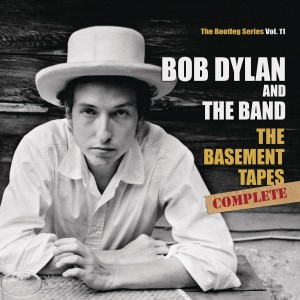Alright, I’m late with this. What can I tell you? It’s six discs long, and unlike some other reviewers, I like to listen to the whole thing, maybe a few times, before adding my two cents. There’s been a lot written about The Basement Tapes Complete (Sony/Legacy) so you already know that Dylan had a motorcycle accident in 1966. A few months later he summoned his backing group, still known as the Hawks, to Byrdcliffe, NY. Beginning in March, 1967, the assembled musicians began recording in Dylan’s living room there, which was known as the Red Room. That summer they moved to the basement of the house in Saugerties that was known as Big Pink.
It’s important to put a frame on all this. It was 1967. Psychedelia was everywhere. The Beatles released Sgt. Pepper, and Jimi Hendrix was in his ascendancy. In the meantime, these guys were down in the basement inventing something that would come to be known as Americana. They couldn’t have bucked musical trends any harder if they tried. For the most part it was over by October. It was at that point that Dylan decamped to Nashville to record John Wesley Harding. Although the album was reflective of the new sound that Dylan was crafting with the Hawks, they were not included on the recording.
By January, 1968, 14 of the recordings with the Hawks were compiled into a publishing demo. The ostensible purpose was to get Dylan’s new songs covered by other artists. That goal was achieved, with artists like Julie Driscoll, Brian Auger & the Trinity, Manfred Mann, the Byrds, and Fairport Convention recording their own versions of the songs. In July, 1969, the first bootleg appeared. The Great White Wonder included seven of the songs of the songs from the demo tape along with other songs that Dylan had recorded earlier in Minnesota. It was the first rock bootleg, but it wouldn’t be the last.
In 1975 Dylan and his manager Albert Grossman relented and allowed 16 of the songs from the basement tapes sessions to be released by Columbia Records. Led by Robbie Robertson, the Band overdubbed new parts onto the original recordings as well as adding some newly recorded Band songs to the double album. That release, the bootlegs, and cover versions of the basement tapes songs is what we’ve had until now.
As far as anyone can tell, The Basement Tapes Complete finally tells the whole story, at least that part of it that could be painstakingly salvaged. There are 138 tracks spread out across six discs and offered in a well-made package that includes extensive liner notes. The set is also available as a two-disc highlights collection, and a three-LP vinyl offering.
What you really want to know about is the music though. Let me put it simply — this music was game-changing when it was recorded, and it remains so today. That’s not to say that a journey through the six discs is a day in the park. Lots of what was recorded here was never meant to be heard by the public. A number of songs end abruptly. If some songs seem to be just tossed off, that’s because they were.
The early discs contain a lot of covers that run the gamut from country to folk to blues and traditional songs. These include Johnny’s Cash’s “Big River,” Pete Seeger and Idris Davies “Bells of Rhymney,” John Lee Hooker’s “Tupelo, the Utah Phillips song “Rock Salt and Nails,” Ian Tyson’s “Four Strong Winds,” and the traditional “Po’ Lazarus.” All well and good, but they were just getting warmed up.
Somewhere on disc two, the new Dylan songs begin to appear more frequently. They are the real gold of this collection. Some of the songs have been heard before on the 1975 release, including “Odds and Ends,” “Million Dollar Bash,” “Yea! Heavy and a Bottle of Bread,” “This Wheel’s On Fire,” and “You Ain’t Goin’ Nowhere,” but they’re heard here for the first time (not counting bootlegs) in their original form.
That leaves the songs that we haven’t heard before, and they are a revelation. The one that stood out for me was “I’m Not There.” The prevailing wisdom is that these songs presage a new direction for Dylan, but “I’m Not There” would not have been out of place on Blonde on Blonde. Other standouts include “Spanish is the Loving Tongue,” “Quinn the Eskimo,” “Sign of the Cross,” “One Too Many Mornings,” and of course “I Shall Be Released.” A number of the songs are presented in multiple takes.
Perhaps it’s not an original idea, but my suggestion is that you listen to all of these songs and use them to create your own basement tapes playlist. It will be a worthwhile use of your time and at the end of the day, no matter which tracks you choose for your compilation, you will have gathered a worthy collection of timeless gems.






Comments